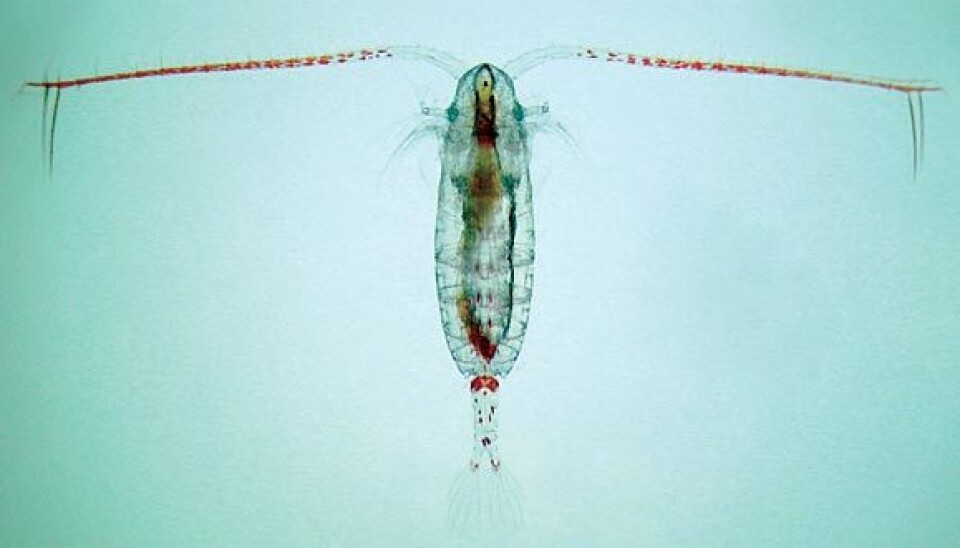An article from Norwegian SciTech News at NTNU

An acidic ocean may mean less fish
Calanus makes up about 90 percent of the bottom of the food chain in northern oceans, and is eaten by fish and baleen whales alike, but as the ocean becomes more acidic, populations may decrease dramatically.
Denne artikkelen er over ti år gammel og kan inneholde utdatert informasjon.
Calanus finmarchicus, or Calanus as it is commonly known, is a small copepod that lives in the Norwegian Sea, in Norwegian fjords, and in the northern Atlantic ocean, which is why its Latin name reflects the geography of northern Norway.
A mature individual is only 3-4 millimetres long, but there are incredible numbers of them. The total biomass of this tiny creature is about 200 million metric tons. In comparison, the biomass of the Norwegian Atlantic herring stock is only about 10 million tons.
Calanus makes up about 90 per cent of zooplankton found in the northern seas. It is one of the most important marine resources in Norwegian waters, and is the main diet of many species of fish, baleen whales, and some sea birds.
“The reason it is so abundant is because of its unique life cycle,” biologist Sindre Andre Pedersen explains. He works at NTNU, and has made important discoveries in his research on C. finmarchicus.
Energy bombs
Every spring, when the sun comes back to the northern part of the globe, phytoplankton come to life, collecting and storing solar energy. Calanus feeds on this phytoplankton, and plays an important part in transferring energy from the sun into the ocean’s food chain.
Calanus is excellent at storing fat— they are like tiny energy bombs. So when winter arrives, they sink down to 1000 metres and stay the winter in the deep, using up their fat reserves.
Then, when the spring sun comes, they rise back up to the surface, stuff themselves with solar-energy-rich phytoplankton to build up their fat stores, reproduce — and provide nutrients for vast amounts of fish, baleen whales and sea birds.
Environmental stress
But what happens if the the ocean is exposed to environmental stress, such as acidification due to increased CO2 emissions? This is what Sindre Andre Pedersen and a group of master’s students at NTNU are studying.
Pedersen has been head of the four-year research project, which is a collaboration between NTNU, SINTEF and the Norwegian Institute for Water Research.
Previous research on the effect of acidification and other climate threats on marine organisms has looked at much shorter time frames.
“It is impossible to study genetic and physiological adaption over such a short time frame. These creatures will adapt to climate change over a number of generations,” Pedersen explains. “By studying a species over several generations, we’re able to observe what happens when the environment around them changes.”
“The Research Council of Norway was interested in supporting the project to collect research-backed data that provides information about threats posed by climate change to C. finmarchicus,” Pedersen says. “We haven’t had much information about this until now.”
Scenario 2100 and 2300
This is the first time anyone has studied the effect of ocean acidification on Calanus for such a long time period.
“It’s been a challenging project. Keeping Calanus alive in a lab for long enough for them to reproduce is difficult. We had to build a unique experimental rig to create completely stable conditions,” Pedersen says.
The research team studied Calanus over two generations, for a total of 136 days. They considered two different scenarios based on two forecasts from the UN IPCC climate report. One forecast is for from the year 2100, and the other from 2300. The water in the experiments was acidified using CO2 levels based on these IPCC predictions.
Increased metabolism
The main discovery has been that Calanus that develop in acidified waters have an increased metabolism.
“We think that this is because the creatures have to use more energy on internal processes to avoid allowing the pH in their bodies to decrease as a result of the acidic environment,” Pedersen said.
“Increased metabolism means increased cellular respiration, but the copepods don’t seem to respond to this by eating more, so the increased metabolism effects their growth, development, fat stores— and reproduction.”
Two generations
In the first generation, the researchers saw a reduced rate of development. The whole life and reproductive cycle of the animals slowed.
The second generation adapted to the changes and normalized its of development, but the following happened:
– Reduced growth (dwarfism in individuals)
– Reduced egg production
– reduced fat reserves
The consequence of the diminished fat reserves is that over winter survival in the deep is more difficult.
Increased metabolism means that Calanus is using more of the solar energy it has captured to adapt and survive the acidified ocean climate. This means that less of that valuable energy is transferred into the rest of the food chain, and the productivity of the ecosystem is lower.
Populations are decreasing
Based on these findings, researchers have compiled simulations for Calanus populations in northern waters, which show that the population may decrease by as much as ten per cent by 2100, and this is only considering the effect of acidification.
Their findings were published in the respected American journal “Environmental Science and Technology”.
The research project has also looked at other types of climate stress, such as increased temperature, increased water salinities, and changes in food availability. Results from these studies will be published in several different journals.






























